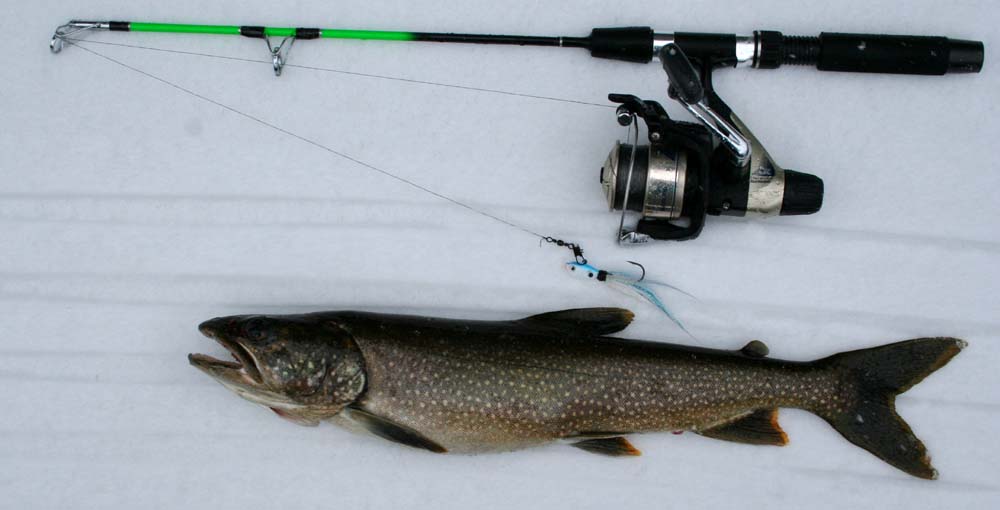Like brook trout, lake trout are a species of char and are a very popular ice fishing target species in regions where deep, glacial lakes are common. A deep-water fish throughout much of the year, lake trout move into shallower water (sometimes as shallow as a few feet) during winter months and can become more accessible to anglers than during the spring, summer, and fall. While lake trout can be difficult to locate and are not always biting, active, hungry, lake trout will bite on a wide variety of baits and require no real skill or finesse to catch. Even small lake trout will provide an exciting fight when hooked.

Above: A lake trout caught via jig during the 2012 season.
Typical Size
Lake trout can, and often do, grow to enormous sizes, occasionally exceeding 30 pounds in weight. Stories abound of ice anglers having difficulty getting large lake trout to fit through 8-inch and 10-inch diameter holes in the ice. A vast majority of iced lakers, however, will weigh in at less than five pounds. In waters that overpopulated with lake trout, a majority of the catch will consist of fish weighing less than three pounds.
Tackle, lures, and bait
Tackle
Tip-ups are an efficient tool for catching lake trout where anglers are allowed to deploy multiple lines. Be sure to rig tip-ups with at least 150 yards of 25 lb test or stronger line as even a small lake trout will run all the line off a minimally wound spool in very little time.
A stout jigging rod with a large-capacity reel is an additional invaluable tool for the wintertime lake trout angler. My preferred jigging setup is an 24-inch long heavy duty spinning rod and reel rigged with 14 lb test or stronger line. While it is a little stiffer and stronger a setup than I need for most of the lake trout I catch, I would hate to find myself under gunned in the event that I hook into one of the rare lunkers that lurk in the deep lakes.
Lures
Large, heavy spoons and bucktail jigs are typically effective on lake trout. I have noticed that lake trout can be oddly particular about lure color, so it is advantageous to have lures and jigs of various color and pattern. A lure tipped with a chunk of baitfish is often a deadly combination.
Bait
Any baitfish will work, but smelt and suckers are particularly effective.

Above: A selection of lake trout jigs.
Fishing methods
During the winter, lake trout will cruise at all depths chasing baitfish. I have caught them in a little as three feet of water and as much as 70 feet. I have caught them by setting bait directly on the bottom, just under the ice, and everything in between. That being said, most of the lake trout I have caught have been within one foot of the bottom in 10 to 50 feet of water.
The unpredictable distribution of lake trout means that an angler must drill a lot of holes. Start in shallow water and move toward deeper water, drilling a hole every 20 to 30 feet in a line that is 100 yards or longer. While most bites will occur within two feet of the bottom, don’t neglect zones nearer to the ice.
When jigging, there is no need for drastic, exaggerated lure movement. Pause the jig periodically as lake trout often strike once a lure has become stationary.
As table fare
Lake trout have an undeservedly bad reputation as a food fish with many people complaining they are too oily and gamy to be palatable. I, however, have found that when prepared properly, lake trout can be exquisite. I prefer to kipper the lake trout I catch but they are also good when marinated in a blend of soy sauce, sugar, and sesame oil, and then broiled or grilled.




